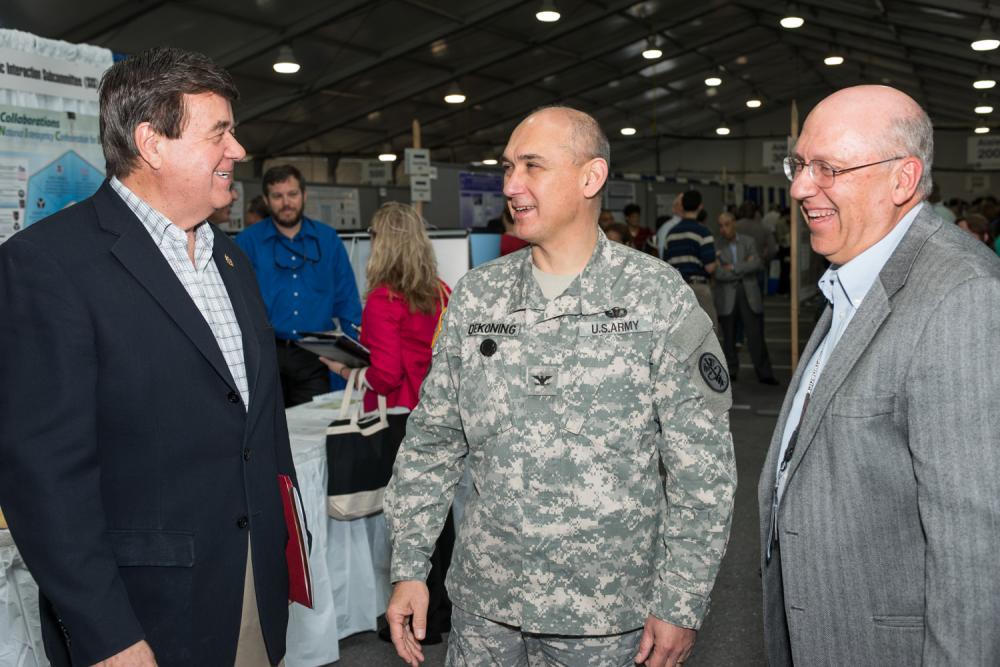By Melissa Porter, Staff Writer
For the past 16 years, the annual Spring Research Festival has been sponsored by NCI at Frederick and Fort Detrick to acquaint fellow researchers, students, and the community at large with the important discoveries being made at this facility to fight cancer, AIDS, and other infectious diseases.
This year marked the first time the Spring Research Festival, held on May 8 and 9, was sponsored by the National Interagency Confederation for Biological Research (NICBR). Every day, collaborations occur between the scientists at the NCI at Frederick and the other agencies located at Fort Detrick. The NICBR sponsorship of the Spring Research Festival highlights the importance of these collaborations and the significant research that is a result of this combined effort.
More than 1,000 people attended the Festival, which featured 151 researchers who presented posters, 34 exhibitors in the Health Education and Community Services Exhibition, and 150 vendors in the Commercial Science and Technology Expo.
Talks Kick Off Festival Week
A postdoctoral and postbaccalaureate symposium on Host Response to Disease was held on May 6, the first day of Festival week. Covering a wide range of areas related to host response, talks were given by postbaccalaureate and postdoctoral fellows working for the various NICBR organizations. Topics included survival and differentiation of hematopoietic stem and progenitor cells potentially being affected by Id2 expression, and resistant and susceptible soybeans following fungal infection. Awards were given to select projects for outstanding presentations by postbaccalaureate and postdoctoral researchers.
Postbaccalaureate winner Katie Stagliano, of the Center for Cancer Research and a graduate student at The George Washington University, presented her thesis research project, which she is conducting in the Laboratory of Molecular Immunoregulation, headed by Andy Hurwitz, Ph.D. She explained her group’s study of very low avidity endogenous memory CD8+ T cells and their effect on tumor growth. The research generated mice that have a very low avidity TCR transgene that is specific for the melanoma antigen tyrosinase-related protein 2. Using these mice, Stagliano described a population of very low avidity endogenous memory (EM)-T cells that delayed subcutaneous B16 melanoma growth when compared with wild-type mice.
These mice, Stagliano said, may provide a useful tool and a unique model for further study of EM-T cells and their effect, and a possible use as an immunotherapeutic tool for combating cancer.
Mandy Kendrick, Ph.D., U.S. Department of Agriculture (USDA) Agricultural Research Service, won an award for best speaker in the postdoctoral category. She described resistance and susceptibility in soybean crops following fungal infections. Demonstrating the importance of soybean crops to the United States, Kendrick also enlightened the audience to some of the challenges that are faced in fighting numerous microbial pathogens that threaten the crops.
Kendrick’s research focuses on Phakopsora pachyrhizi, a fungus that causes the destructive disease Asian soybean rust (ASR) and was first detected in the U.S in 2004. Currently, there are no ASR-resistant soybeans commercially available to U.S farmers. Kendrick has identified novel secondary metabolites produced in soybeans as a resistance response to P. pachyrhizi. Through microarray analysis and gene silencing, a lengthy process in plants, Kendrick is gaining further understanding of metabolite production during the ASR-resistance response and is able to build a more detailed model of microbial pathogen resistance in soybeans. Her studies could ultimately lead to development of a broad-spectrum resistant line of soybeans.
Winners received a travel subsidy as well as a certificate recognizing their achievement. In addition to Stagliano, an award was given to Shakir Saud, Laboratory of Cancer Prevention, in the postbaccalaureate category. Postdoctoral winners included, in addition to Kendrick, Mairi McLean, Laboratory of Molecular Immunoregulation, NCI; Janani Varadarajan, HIV Drug Resistance Program, NCI; and John Trefry, U.S. Army Medical Research Institute for Infectious Diseases.


